- Home
- Charles de Lint
Dreams Underfoot n-1
Dreams Underfoot n-1 Read online
Dreams Underfoot
( Newford - 1 )
Charles De Lint
Myth, music, and magic, and dreams underfoot .
Welcome to Newford ..
Welcome to the music clubs, the waterfront, the alleyways where ancient myths and magic spill into the modern world. Come meet Jilly, painting wonders in the rough city streets; and Geordie, playing fiddle while he dreams of a ghost; and the Angel of Grasso Street gathering the fey and the wild and the poor and the lost. Gemmins live in abandoned cars, and skells traverse the tunnels below, while mermaids swim in the gray harbor waters and fill the cold night with their song.
Like Mark Helprin’s Winter’s Tale and John Crowley’s Little, Big, Dreams Underfoot is a mustread book not only for fans of urban fantasy but for all those who seek magic in everyday life.
“In de Lint’s capable hands, modern fantasy becomes something other than escapism. It becomes folk song,—the stuff of urban myth.”
— The Phoenix Gazette
“Charles de Lint shows that, far from being escapism, contemporary fantasy can be the deep mythic literature of our time.”
—The Magazine of Fantasy & Science Fiction
Tread softly because you tread on my dreams.
—W. B. Yeats, from “He wishes for the cloths of heaven”
Dreams Underfoot
Sources
“Uncle Dobbin’s Parrot Fair” first appeared in Isaac Asimov’s Science Fiction Magazine, November 1987.
“Timeskip” first appeared in Post Mortem, edited by Paul F. Olson and David B. Silva; St. Martin’s Press, 1989.
“That Explains Poland” first appeared in Pulphouse, the Hardback Magazine #2.
“Freewheeling” first appeared in Pulphouse, the Hardbook Magazine #6.
“Romano Drom” first appeared in Pulphouse, the Hardback Magazine #3.
“The Sacred Fire” first appeared in Stalkers, edited by Ed Gorman and Martin H. Greenberg; Dark Harvest, 1989.
“The Stone Drum” was first published by Triskell Press, 1989.
“Winter Was Hard” first appeared in Pulphouse, the Hardback Magazine #10.
“Paperjack” was first published by Cheap Street, 1991.
“Bridges” first appeared in The Magazine of Fantasy and Science Fiction, October/November 1992.
“Tallulah” first appeared in Dead End: City Limits, edited by Paul F. Olson and David B. Silva; St.
Martin’s Press, 1991.
“Small Deaths” is original to this collection.
“Ghosts of Wind and Shadow” was first published by Triskell Press, 1990.
“Pity the Monsters” first appeared in The Ultimate Frankenstein, edited by Byron Preiss; Dell, 1991.
“The Conjure Man” first appeared in After the King, edited by Martin H. Greenberg; Tor Books, 1992.
“Our Lady of the Harbour” was first published by Axolotl Press, 1991.
“In the House of My Enemy” is original to this collection.
“The Moon Is Drowning While I Sleep” was first published in Snow White, Blood Red, edited by Ellen Datlow and Terri Windling; William Morrow and Co., 1993.
“But for the Grace Go I” first appeared in Chilled to the Bone, edited by Robert T. Garcia; Mayfair Games, Inc., 1991.
Acknowledgments
Creative endeavors require inspiration and nurturing, and these stories are no exception. I’d like to take this opportunity to thank a few people who were important to the existence of this collection: First and foremost, my wife MaryAnn, not only for her indefatigable work as first reader and editor, but also for her part in the genesis of many of the individual stories; Terri Windling, for her ongoing support, both professionally and personally, especially with this cycle of stories, and for providing the collection’s title, which was also the title of her 1992 onewoman art show at the Book Arts Gallery in Tucson, Arizona;
Kris Rusch and Dean Smith of Axolotl Press/Pulphouse Publishing, who were always asking for more stories and provided the first home for many of these;
And for all those other editors who gave me the opportunity to take a holiday from longer work to explore Newford’s streets: Bruce Barber, Ellen Datlow, Gardner Dozois, Robert T. Garcia, Ed Gorman, Martin H. Greenberg, Cara Inks, Paul F. Olson, Jan and George O’Nale, Byron Preiss and David B. Silva.
Introduction
The book you hold is neither a novel nor a simple gathering of short stories. Rather, it is a cycle of urban myths and dreams, of passions and sorrows, romance and farce woven together to create a tapestry of interconnected dramas, interconnected lives—the kind of magic to be found at the heart of any city, among any tightly knit community of friends. If the imaginary city of Newford is more mythic, more mysterious than the cities you have known, that may be only because you’ve not seen them through Charles de Lint’s eyes, through the twilight dreams he weaves out of language and music. Here he spreads these dreams before us and bids us, in the words of Yeats’s poem, to tread softly, for urban magic is fleeting and shy .. . and its touch is a transformation.
Joseph Campbell, Carl Jung, James Hillman, LouiseMarie von Franz and others have written eloquently and extensively about the importance of myth in our modern society, the need for tales rich in archetypal images to give coherence to fragmented modern lives. “Using archetypes and symbolic language,” writes folklore scholar and author Jane Yolen, “[fantasy tales] externalize for the listener conflicts and situations that cannot be spoken of or explained or as yet analyzed. They give substance to dreams .. . [and] lead us to the understanding of the deepest longings and most daring visions of humankind. The images from the ancients speak to us in modern tongue though we may not always grasp the ‘meanings’ consciously. Like dreams, the meanings slip away, leaving us shaken into new awarenesses. We are moved by them, even when—or perhaps because—we do not understand them on a conscious level. They are penumbral, partially lit, and it is the dark side that has the most power. So when the modern mythmaker, the writer of literary fairy tales, dares to touch the old magic and try to make it work in new ways, it must be done with the surest of touches.”
De Lint is one of those writers who mine this vein with a deft, sure touch. Readers new to his distinctive brand of “urban fantasy” might find his mix of ancient folklore motifs and contemporary urban characters somewhat startling—for ours is a society that loves to separate and classify, putting “fantasy”
fiction on a shelf far away from books of “realistic” or “mainstream” fiction (despite the fact that the mainstream shelves include works of modern fantasy by foreign authors such as Calvino, Allende and Garcia Marquez). While American book distributors and critics continue to build up genre walls, writers like de Lint are quietly laboring to take them down again, brick by brick, story by story. Forget the labels. Forget the assumptions you make when you think of fantasy, or even short story collections.
And then you will be able to fully enter the enchanted streets de Lint has created.
We enter Newford via the more familiar streets of Los Angeles, via the tales of Newford author Christy Riddell; and then de Lint leads us on to Newford itself, a North American city that might exist anywhere or nowhere, thousands of miles away or just past the next exit on the Interstate. Like any city, Newford has its posh districts, its slums, its daylife and nightlife and the twilight between; but most of all it’s the street people, the downtown people, that de Lint wants us to meet: the buskers and artists, punkers and gypsies, street walkers and wizards and runaway kids, people for whom magic is not just a supernatural visitation but a manifestation of the soul’s deepest longings and a bright spark of hope lodged within a desperate heart. The greatest magic on the streets of Newford is the magic o
f community, of friendship and love, support and compassion—for these are the larger themes de Lint uses the bright symbols of folklore to address.
In Newford, creation is the supreme act of magic, whether that creation be a painting, a fiddle tune or a poem, an AIDS clinic or battered children’s shelter, or one’s own family and a harmonious way of life. By these acts we create magic in our own lives; by these acts, large and small, we reinvent the world.
For de Lint, these acts are transformed into stories to nurture the growth of his Tree of Tales, which contains the collective stories of the world:
“The Tree of Tales,” says de Lint’s Conjure Man, “is an act of magic, an act of faith. Its existence becomes an affirmation of the power that the human spirit can have over its own destiny. The stories are just stories—they entertain, they make one laugh or cry—but if they have any worth they carry with them a deeper resonance that remains long after the final page is turned ....”
The interconnected stories of the Newford cycle are a particularly lovely new limb on that ancient tree, and one that shall grow and flower beyond the pages of this single book as de Lint continues to explore Newford’s myriad streets.
In his own city of Ottawa, in Canada, Charles de Lint is a novelist, a poet, a fiddler, a fluteplayer, a painter, a critic and folklore scholar; but most of all he is a magician: the kind who makes magic with his multidisciplined creativity, with the tools of myth, folklore and fantasy. “I think those of us who write fantasy,” said fellow author Susan Cooper in her Newbery Award acceptance speech, “are dedicated to making impossible things seem likely, making dreams seem real. We are somewhere between the Abstract and Impressionist painters. Our writing is haunted by those parts of our experience which we do not understand, or even consciously remember. And if you, child or adult, are drawn to our work, your response comes from that same shadowy land .... I have been attempting definitions, but I am never really comfortable when writing about ‘fantasy.’ The label is so limiting. It seems to me that every work of art is a fantasy, every book or play, painting or piece of music, everything that is made, by craft and talent, out of somebody’s imagination. We have all dreamed, and recorded our dreams as best we could.”
In these pages, de Lint has recorded dreams: Jilly Coppercorn’s and Geordie’s, Sophie’s and Christy’s, Tallulah’s and the dreams of Newford itself. There are dreams underfoot here, some fragile as spiders’ webs, others solid as asphalt and brickcobbled streets. As you walk into the heart of the city of Newford, remember: tread warily. Tread softly.
—Terri Windling ( Coeditor of “The Year’s Best Fantasy” annual collection) Weaver’s Cottage, Devon, 1992
Uncle Dobbin’s Parrot Fair
1
She would see them in the twilight when the wind was right, rolypoly shapes propelled by ocean breezes, turning endover-end along the beach or down the alley behind her house like errant beach balls granted a moment’s freedom. Sometimes they would get caught up against a building or stuck on a curb and then spindly little arms and legs would unfold from their fat bodies until they could push themselves free and go rolling with the wind again. Like flotsam in a river, like tumbleweeds, only brightly colored in primary reds and yellows and blues.
They seemed very solid until the wind died down. Then she would watch them come apart the way morning mist will when the sun burns it away, the bright colors turning to ragged ribbons that tattered smokelike until they were completely gone.
Those were special nights, the evenings that the Balloon Men came.
In the late sixties in HaightAshbury, she talked about them once. Incense lay thick in the air—two cones of jasmine burning on a battered windowsill. There was an old iron bed in the room, up on the third floor of a house that no one lived in except for runaways and street people. The mattress had rustcolored stains on it. The incense covered the room’s musty smell. She’d lived in a form of selfimposed poverty back then, but it was all a part of the Summer of Love.
“I know what you mean, man,” Greg Longman told her. “I’ve seen them.”
He was wearing a dirty white Tshirt with a simple peace symbol on it and scuffed plastic thongs.
Sticking up from the waist of his bellbottomed jeans at a fortyfive degree angle was a descant recorder. His long blonde hair was tied back with an elastic. His features were thin—an asceticlooking face, thin and drawnout from too much time on the streets with too little to eat, or from too much dope.
“They’re like ...” His hands moved as he spoke, trying to convey what he didn’t feel words alone could say—a whole other language, she often thought, watching the long slender fingers weave through the air between them. “... they’re just too much.”
“You’ve really seen them?” she asked.
“Oh, yeah. Except not on the streets. They’re floating high up in the air, y’know, like fat little kites.”
It was such a relief to know that they were real.
“‘Course,” Greg added, “I gotta do a lot of dope to clue in on ’em, man.
Ellen Brady laid her book aside. Leaning back, she flicked off the light behind her and stared out into the night. The memory had come back to her, so clear, so sharp, she could almost smell the incense, see Greg’s hands move between them, little colored afterimage traces following each movement until he had more arms than Kali.
She wondered what had ever happened to the Balloon Men.
Long lightbrown hair hung like a cape to her waist. Her parents were Irish—Munster O’Healys on her mother’s side, and Bradys from Derry on her father’s. There was a touch of Spanish blood in her mother’s side of the family, which gave her skin its warm dark cast. The Bradys were pure Irish and it was from them that she got her bigboned frame. And something else. Her eyes were a clear grey—twilight eyes, her father had liked to tease her, eyes that could see beyond the here and now into somewhere else.
She hadn’t needed drugs to see the Balloon Men.
Shifting in her wicker chair, she looked up and down the beach, but it was late and the wind wasn’t coming in from the ocean. The book on her lap was a comforting weight and had, considering her present state of mind, an even more appropriate title. How to Make the Wind Blow. If only it was a tutor, she thought, instead of just a collection of odd stories.
The author’s name was Christy Riddell, a reedthin Scot with a head full of sudden fancies. His hair was like an unruly hedgerow nest and he was half a head shorter than she, but she could recall dancing with him in a garden one night and she hadn’t had a more suitable partner since. She’d met him while visiting friends in a house out east that was as odd as any flight of his imagination. Long rambling halls connected a bewildering series of rooms, each more fascinating than the next. And the libraries. She’d lived in its libraries.
“When the wind is right,” began the title story, the first story in the book, “the wise man isn’t half so trusted as the fool.”
Ellen could remember when it was still a story that was told without the benefit ofpen and paper. A story that changed each time the words traveled from mouth to ear: There was a gnome, or a gnomish sort of a man, named Long who lived under the pier at the end of Main Street. He had skin brown as dirt, eyes blue as a clear summer sky. He was thin, with a fat tummy and a long crooked nose, and he wore raggedy clothes that he found discarded on the beach and wore until they were threadbare. Sometimes he bundled his tangled hair up under a bright yellow cap. Other times he wove it into many braids festooned with colored beads and the discarded tabs from beer cans that he polished on his sleeve until they were bright and shiny.
Though he’d seem more odd than magical to anyone who happened to spy him out wandering the streets or along the beach, he did have two enchantments.
One was a pig that could see the wind and follow it anywhere. She was pink and fastidiously clean, big enough to ride to market—which Long sometimes did—and she could talk. Not pigtalk, or even pigLatin, but plain English that anyone cou
ld understand if they took the time to listen. Her name changed from telling to telling, but by the time Long’s story appeared in the book either she or Christy had settled on Brigwin.
Long’s other enchantment was a piece of plain string with four complicated elfknots tied in it—one to call up a wind from each of the four quarters. North and south. East and west. When he untied a knot, that wind would rise up and he’d ride Brigwin in its wake, sifting through the debris and pickings left behind for treasures or charms, though what Long considered a treasure, another might throw out, and what he might consider a charm, another might see as only an old button or a bit of tangled wool. He had a good business trading his findings to woodwives and witches and the like that he met at the market when midnight was past and gone, ordinary folk were in bed, and the beach towns belonged to those who hid by day, but walked the streets by night.
Ellen carried a piece of string in her pocket, with four complicated knots tied into it, but no matter how often she undid one, she still had to wait for her winds like anyone else. She knew that strings to catch and call up the wind were only real in stories, but she liked thinking that maybe, just once, a bit of magic could tiptoe out of a tale and step into the real world. Until that happened, she had to be content with what writers like Christy put to paper.
He called them mythistories, those odd little tales of his. They were the ghosts of fancies that he would track down from time to time and trap on paper. Oddities. Some charming, some grotesque. All of them enchanting. Foolishness, he liked to say, offered from one fool to others.
Ellen smiled. Oh, yes. But when the wind is right ...
She’d never talked to Christy about the Balloon Men, but she didn’t doubt that he knew them.

 Widdershins
Widdershins The Ivory and the Horn
The Ivory and the Horn Yarrow
Yarrow The Blue Girl
The Blue Girl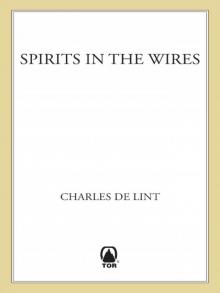 Spirits in the Wires
Spirits in the Wires The Painted Boy
The Painted Boy The Little Country
The Little Country Jack of Kinrowan: Jack the Giant-Killer / Drink Down the Moon
Jack of Kinrowan: Jack the Giant-Killer / Drink Down the Moon Moonheart
Moonheart Dreams Underfoot
Dreams Underfoot Into the Green
Into the Green Trader
Trader Spiritwalk
Spiritwalk Someplace to Be Flying
Someplace to Be Flying Jack in the Green
Jack in the Green The Valley of Thunder
The Valley of Thunder Out of This World
Out of This World The Cats of Tanglewood Forest
The Cats of Tanglewood Forest Seven Wild Sisters
Seven Wild Sisters Memory and Dream
Memory and Dream The Very Best of Charles De Lint
The Very Best of Charles De Lint Under My Skin
Under My Skin Forests of the Heart
Forests of the Heart The Newford Stories
The Newford Stories Moonlight and Vines
Moonlight and Vines Angel of Darkness
Angel of Darkness The Onion Girl
The Onion Girl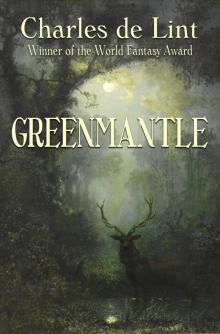 Greenmantle
Greenmantle Waifs And Strays
Waifs And Strays From a Whisper to a Scream
From a Whisper to a Scream Over My Head
Over My Head The Ivory and the Horn n-6
The Ivory and the Horn n-6 Our Lady of the Harbour
Our Lady of the Harbour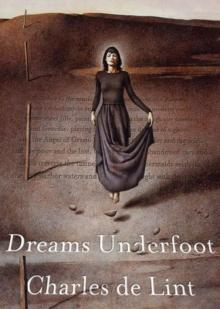 Dreams Underfoot n-1
Dreams Underfoot n-1 Jack the Giant-Killer (Jack of Kinrowan Book 1)
Jack the Giant-Killer (Jack of Kinrowan Book 1)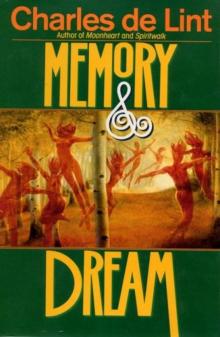 Memory and Dream n-5
Memory and Dream n-5 Under My Skin (Wildlings)
Under My Skin (Wildlings) Newford Stories
Newford Stories The Wind in His Heart
The Wind in His Heart Ivory and the Horn
Ivory and the Horn